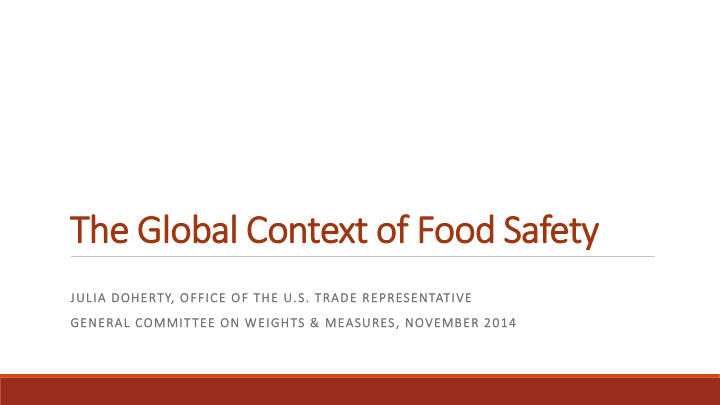



The Global Context of Food Safety JULIA DOHERTY, OFFICE OF OF THE U.S. TRADE REPRESENTATIVE GENERAL COMMITTEE ON ON WEIGHTS & MEASURES, NOVEMBER 2014
Market and Policy Drivers
Food security "exists when all people, at all times, have physical and economic access to sufficient, safe and nutritious food to meet their dietary needs and food preferences for an active and healthy life.” World Food Summit, 1996
The world needs to produce at least 50% more food to feed 9 billion people by 2050. FAO, 2012
A positive effect on reducing poverty also materializes if agricultural productivity is enhanced through the integration of developing countries into global value chains – effectively world production lines. WTO, 2014
A Multinational Loaf • Wheat gluten – France, Poland, Russia, Netherlands, Australia • Honey – China, Vietnam, Brazil, Uruguay, India, Canada, Mexico, Argentina • Calcium proprionate – Netherlands • Guar gum – India • Flour enrichments – China • Beta-carotene – Switzerland • Vitamin D3 – China New York Times, June 15, 2007
An important phenomenon of the past 50 years has been that the share of raw traditional agricultural exports in global agricultural exports has declined significantly, implying that the weight of high value- added agricultural trade has increased … Processed agricultural products now represent over 60 per cent of total exports of agricultural goods. WTO, 2014
In terms of value, exports of agricultural products nearly tripled between 2000 and 2012. In volume terms, exports increased by around 60 per cent over the same period. WTO, 2013
Economic analysis of food safety related costs showed that it is much cheaper for a producer to invest in preventing events of foodborne outbreaks than the cost after an event. Hussain & Dawson, 2013
Sound policies, robust institutions, and well-functioning markets complement technological discovery in agricultural science to ensure that consumers have access to nutritious and affordable food, producers have incentives to plant and harvest, and the myriad participants in complex value chains are well linked in mutually beneficial connections . IFPRI, 2014
WTO Rules Disclaimer: This section is not intended to provide legal advice.
The WTO Agreement on the Application of Sanitary and Phytosanitary (SPS) Measures Preserves WTO Members’ rights to set the appropriate level of health protection, Promotes harmonization on the basis of international standards, and Establishes obligations to prevent disguised restrictions on international trade.
WTO SPS Agreement – Science is Fundamental Allows countries to establish own SPS measures (SPS laws, regulations, etc.). However, these must be based on scientific principles and an appropriate assessment of risks taking into account available scientific evidence. Measures may only be applied to the extent necessary to protect human, animal or plant life or health, and inter alia may not be maintained without scientific evidence; and Cannot arbitrarily or unjustifiably discriminate in favor of domestic producers (“national treatment”) or between specific trading partners.
WTO SPS Agreement – Key Concepts for NMIs Requires recognition of equivalence if exporting country objectively demonstrates to the importing country that its measures achieve the importing country’s level of SPS protection . Requires WTO Members, upon request, to enter into consultations for bilateral and multilateral agreements on the recognition of equivalence of specified SPS measures. Transparency: Notification to WTO Members regarding certain proposed SPS regulations that have a significant effect on trade, allow comments on them, and take comments into account.
Some Trade Challenges
Tolerances Not Based on Science
Laboratory competence and independence
Detained Shipments
Availability of Reference Material
Closing Thoughts
Trade and technological advancements will be the dual engines for efficient allocation of resources and for increases in agricultural productivity that enables us to achieve global food security in the decades ahead.
Both public sector regulatory frameworks and private sector market drivers must support effective implementation of risk-based food safety systems (e.g., HACCP) in food value chains.
Limits for microbial and chemical contaminants must be based on risk and must take account of the maturity of measurement science on the particular substance.
Recognition and acceptance of products will depend on the continued advancement of national and international technical infrastructure.
Mechanisms and procedures at the national level for coordination and cooperation are essential among • the agencies responsible for food safety regulation, metrology & trade, • domestic industry and agricultural interests, • the standards and conformance community, and • partners in the scientific community, including academia.
Julia Doherty Senior Director, SPS & Agricultural Affairs Office of the U.S. Trade Representative 202 395 9559 Julia_Doherty@ustr.eop.gov
Recommend
More recommend